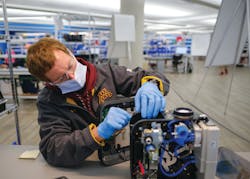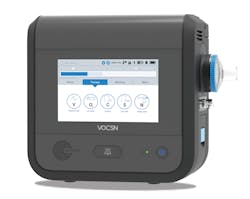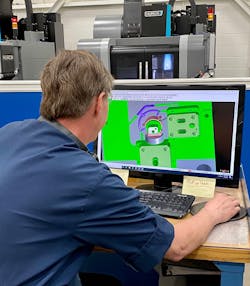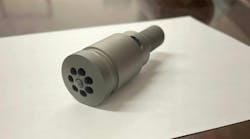Solution: Autodesk’s warpage simulations helped engineers improve the mold design.
By Karen Hanna
The uncertainty of the first few months of the COVID-19 pandemic sparked panic, as offices and schools emptied out and people rushed to buy the essentials they thought they would need to survive weeks in isolation.
Companies, too, felt the urgency.
For the managers of PTI Engineered Plastics, it began with a meeting on a Saturday in March, when they gathered to discuss the possibility of gearing up for “the most aggressive delivery we have ever been asked to achieve,” account manager Lou Garofalo said.
General Motors Co., which normally sources some of its parts from PTI, had a new project in mind for the mold maker and plastics processor — mass production of ventilator parts originally designed by Ventec Life Systems, a Bothell, Wash., company.
“Though press availability is often an issue, obviously these parts would take precedence over anything else we were currently running,” Garofalo said.
“There was definitely a sense throughout the company that we were working on something of great importance,” said Chris Behring, tooling operations manager for PTI.
PTI submitted its plans the following day.
About two weeks later, on April 8, the U.S. Department of Health and Human Services awarded GM a contract under the Defense Production Act. Having pressed its suppliers into service, GM pledged to assemble ventilators at a facility in Indiana. It would make 30,000 ventilators by the end of August — half by the end of June. On its own, Ventec made just about 200 a month.
Shortly after the contract was awarded, more than 600 miles away from PTI and GM’s Midwestern plants, New York City and state officials began pleading for tens of thousands of ventilators.
Simplifying the process
“Everybody’s in a rush-rush to get ventilators, and it’s a mad dash to suck up the supply,” said Tim Lankisch, director of engineering for CAE Services, Batavia, Ill., an engineering consulting company that collaborated on the project.
Conceived originally as a mobile unit, Ventec’s 18-pound, suitcase-sized VOCSN V+Pro Emergency Critical Care Ventilator performs five separate functions. It works as a ventilator, delivers varying levels of oxygen as needed, performs suction, nebulizes medications and features a mode for patients who require cough therapy.
The devices are complicated pieces of equipment, with more than 700 different components. PTI took on a handful of the parts.
While Ventec already had molds for the ventilator parts, the project called for additional molds to increase capacity. That presented an opportunity to improve existing mold and part designs, which is where CAE Services could help.
A partner of GM for more than a decade, the company uses Autodesk Insight software to simulate the injection molding process. It joined the project to help improve and optimize Ventec’s original designs.
A couple parts, including a bracket that holds components critical to oxygen metering, were particularly troublesome, Lankisch said.
“Originally, the part that we worked on was machined out of a block of material, which is a very slow and expensive process, so that’s when they turned to injection molding. They had an injection mold, but the parts that were being created off of that, they felt they could improve on that,” he said.
The parts from the original mold were made from a fiber-reinforced PEEK material and had a tendency to warp in unpredictable ways, due to the location of the gate and problems involving non-uniform fiber orientation. To combat the problem, CAE Services advised that PTI’s mold makers adjust the location of the gate in a new design of the mold. Mold makers also decided to make the gate larger, which reduced the visibility of sink marks evident in the original parts.
To address the warping problem, they leveraged a concept known as windage, using Autodesk’s Moldflow software. Lankisch, who hails from Kentucky, drew an analogy to shooting with the long guns of his native state, to explain the fix.
“Imagine a Civil War-era-type rifle, and you are 100 yards away, and you need to hit this bullseye … but the wind is blowing left to right at 20 miles per hour, so you’re going to aim left to get the bullet to the target. That’s what windage is. That’s where the term came from, so it’s the wind, or windage, that you are compensating for,” he said.
Windage simulations intentionally warped the mold in the opposite direction of the part’s typical bend. Using data from these simulations, as well as those examining gate layout and size, CAE Services and PTI devised a mold design that held to tolerances much more tightly than the mold Ventec originally employed.
“When you’re doing things fast, you want your parts to assemble well, and, if your tolerances are off, that can create problems for assembly,” Lankisch said.
Tolerances were very tight, with a perpendicularity within 0.01 inch and 0.0025 inch. Measured results of parts from the original mold came in at 0.014 inch and 0.008 inch. The new mold performed even even better — within 0.004 inch and 0.0012 inch.
In all, CAE Services worked on seven parts, most of them glass-filled, trying to find ways to produce them with more efficiency and precision. For instance, the injection mold didn’t always fill correctly for one part.
“We found out that they had the runner way oversized and the molding machine that they were using was way oversized, so they couldn’t fill this little blip of material,” Lankisch said.
Getting the parts just right ensured more could be produced more quickly with fewer rejects, to meet the teams’ demanding timetable.
The software allowed the team to avoid expensive and time-consuming adjustments to molds, according to GM.
No time to lose
Representatives of companies involved in the VOCSN V+Pro said they took special pride in being able to help.
Behring said PTI normally might have needed a couple months to turn around the molds, tooling and parts it produced. He lauded CAE Services’ expertise in beating the clock, and improving part repeatability.
“Without this engineering activity, the mold would have likely required several grooming cycles to meet requirements, resulting in increased lead time and more dimensional variation in the finished part,” Behring said of some of the refinements made through Autodesk simulations. “These molds with their special requirements would typically be built in six to 10 weeks. As a result of the collaborative approach ... we completed the molds in two and three weeks.”
Mold simulations — often still viewed with skepticism by some mold makers who consider the process time-consuming or intimidating — provided critical efficiencies, said representatives of PTI, CAE Services and Autodesk.
“Mold flows provided by … CAE Services helped us get one of the parts almost perfect on first shots,” Behring said. “The advanced mold-flow software they used accurately depicted how this part of critical function would react to the molding and cooling process.”
While CAE Services is accustomed to tight deadlines, it felt a new urgency in dealing with a crisis involving the health-care industry, Lankisch said. Typically, he said that industry takes a more deliberate approach.
Fortunately, CAE Services needed only a week to complete all simulations and CAD morphing for a full windage analysis, allowing its partners to move quickly, Lankisch said. Its work on the oxygen-
metering bracket took just four days.
Making an impact
In the 145 days between April 8, when GM landed its contract, and Aug. 31, when it delivered the 30,000th ventilator, a network of companies with thousands of employees churned out one VOCSN V+Pro ventilator every seven minutes, GM estimated.
“I am extremely grateful to be a part of such an impacting project because even though I do not have a medical degree, I was able to use my skillset and give back to many people who were in desperate need of help,” said Alison Stark, a GM manufacturing engineer. While GM quit ventilator production, PTI continues to manufacture essentials the crisis demands.
“Everyone at PTI feels a sense of pride whenever we complete any project,” Behring said. “With such a nationwide emphasis on this project, those feelings were magnified for sure. … When we look back on this moment, I think we can all feel proud of what we were able to accomplish.”
Karen Hanna, associate editor
Contact:
Autodesk Inc., San Rafael, Calif., 415-507-5000, www.autodesk.com
CAE Services, Batavia, Ill., 630-761-9898, https://caeservices.com
PTI Engineered Plastics Inc., Macomb, Mich., 586-263-5100, https://teampti.com








